Recently, a social media post ignited a debate over something you might not have thought much about—your pillow. Specifically, a user named Cam shared a picture of his beloved “yellow pillow,” leading to an online discussion about why pillows turn yellow over time and why so many people seem attached to these discolored cushions. Cam’s post revealed an unexpected passion for what he called “The Yellow Pillow,” claiming that his worn pillow grants him “the most peaceful slumber.” Let’s explore why pillows turn yellow, the science behind this common phenomenon, and how to keep your pillows fresh and clean.
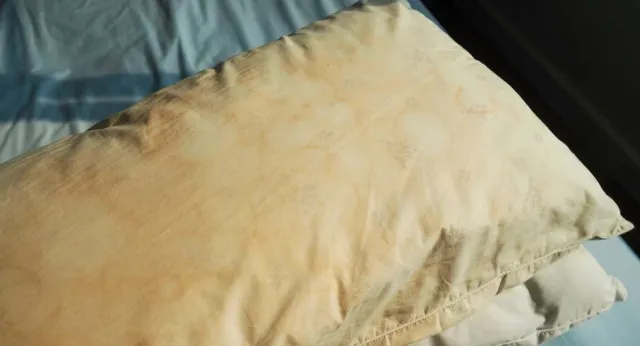
The man, named Cam, claims the yellow pillow offers him peaceful sleep despite its appearance. Image Credits: Getty
The Viral Debate: Why Are People So Attached to Their Yellow Pillows?
When Cam shared his post on social media, he likely had no idea it would spark a wave of reactions from people sharing similar experiences. His tweet, which included a photo of his yellowed pillow, read: “Gf is mad at me because I have revealed to her The Yellow Pillow. Fellas, I’m sure you all know that this thing is magic. It’s not my fault the pillow is yellow and bestows upon me the most peaceful slumber.”
Responses poured in, with many sharing their own experiences and even nostalgia for their own yellow pillows. Some users confessed that they’ve held onto their pillows for years, while others were quick to express disgust. But why do pillows turn yellow in the first place, and is there a reason why people become so attached to these less-than-pristine cushions?
What Causes Pillows to Turn Yellow?
The primary cause of pillow discoloration is moisture, and it can come from several sources. Over time, a combination of sweat, oils, and other factors contribute to the gradual yellowing of pillows. Here are the main culprits behind this common issue:
1. Sweat: The Leading Cause of Yellow Stains
When we sleep, our bodies continue to perspire, even if we don’t realize it. Sweat can seep through pillowcases and into the pillow itself. Over time, the accumulation of sweat stains leads to that characteristic yellowing. The minerals in sweat, particularly salt, play a role in staining fabrics as well.
2. Saliva and Drool
If you tend to drool while you sleep, this can also cause yellowing. Saliva contains proteins and other natural substances that can leave marks on fabric, and if left untreated, these marks can build up and cause significant discoloration over time.
3. Natural Oils from Skin and Hair
Our skin and hair produce natural oils that transfer to our bedding. Even if you wash your face before bed, your skin still releases oils as you sleep. These oils can be absorbed by the pillow and, over time, cause yellow staining. Those with oily skin may notice faster discoloration.
4. Skincare Products and Hair Products
If you apply lotion, face oils, or leave-in conditioners before bed, these products can rub off onto your pillowcase and eventually seep into your pillow. Ingredients like oils and certain chemicals can discolor fabrics, accelerating the yellowing process.
5. Sleeping with Wet Hair
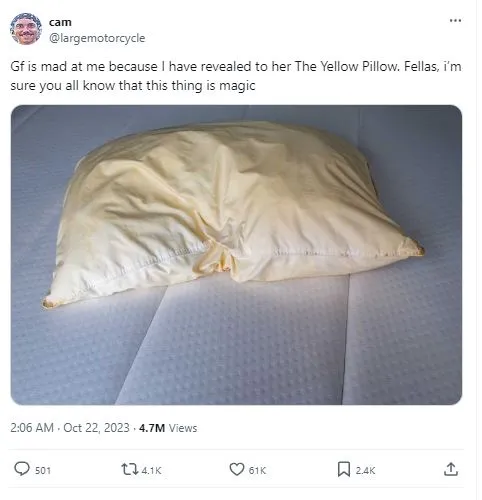
A viral post discusses the debate around a man’s ‘Yellow Pillow’ and its unwashed condition. Image Credits: @largemotorcycle/X
If you go to bed with damp or wet hair, it can speed up the yellowing of your pillow. Moisture from your hair, combined with any styling products you’ve used, can soak into the pillow, leaving behind residue that contributes to discoloration. Always drying your hair before bed can help minimize this effect.
How to Prevent Pillows from Turning Yellow
While yellowing is a natural part of pillow aging, there are steps you can take to slow down the process and keep your pillows looking fresh. Here are a few practical tips:
1. Use Pillow Protectors
Pillow protectors act as a barrier between your pillowcase and the pillow itself. They help block sweat, oils, and other substances from penetrating the pillow. You can wash the pillow protector regularly to keep your pillow clean and fresh.
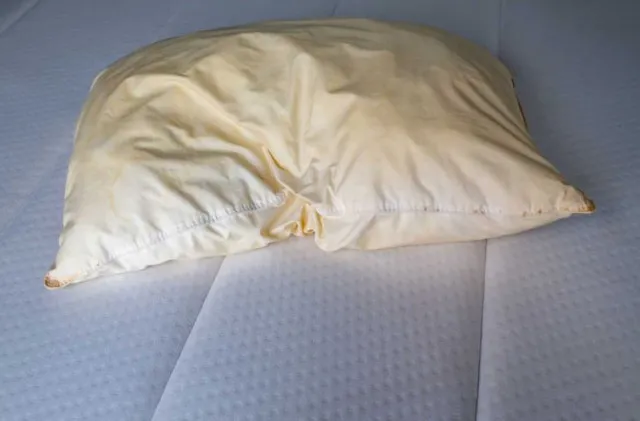
Additional factors like damp hair and skincare products can also contribute to the yellowing of pillows. . Image Credits: Getty
2. Wash Your Pillowcases Regularly
Changing and washing your pillowcases every week can significantly reduce the amount of sweat, oils, and dirt that reaches your pillow. Choose breathable, moisture-wicking pillowcases that can help absorb and dissipate moisture more effectively.
3. Air Out Your Pillow
Every few weeks, take your pillow outside to air it out. Fresh air can help remove lingering odors and reduce moisture buildup. Make sure to do this on a dry day to avoid adding additional moisture to the pillow.
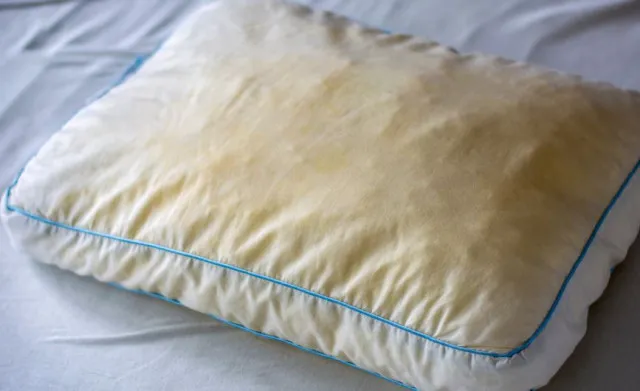
Many users shared their experiences, with some lamenting the loss of their own yellowed pillows. . Image Credits: Getty
4. Wash Your Pillow
Many pillows are machine washable, especially synthetic or down alternatives. Washing your pillow every few months can help eliminate sweat and oil buildup. Be sure to follow the care instructions for your specific pillow type to avoid damage.
5. Dry Your Hair Before Bed
Sleeping with dry hair prevents excess moisture from soaking into your pillow. If you wash your hair at night, consider drying it thoroughly or wearing a hair wrap to keep it from transferring moisture to your pillow.
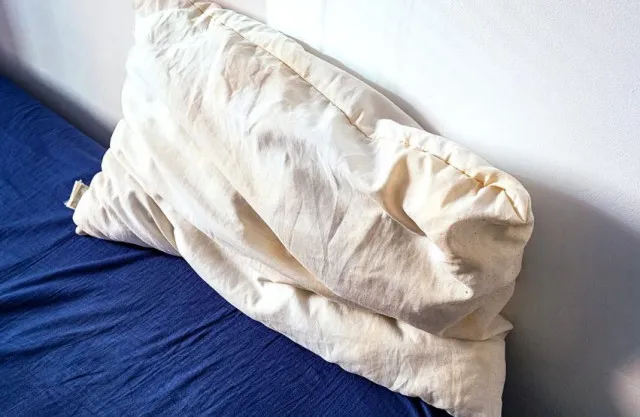
Pillows turn yellow primarily due to moisture, including sweat, saliva, and skin oils. . Image Credits: Getty
Should You Replace Your Pillow?
While washing and using protective measures can help extend the life of your pillow, there comes a time when replacement is the best option. Over time, pillows not only yellow but also accumulate dust mites, allergens, and bacteria that can impact your health. Here’s a quick guide to knowing when it’s time to let go:
- When It Loses Shape: If your pillow no longer offers proper support or feels flat, it’s time for a new one. A supportive pillow is essential for good sleep posture and can reduce neck and back pain.
- Frequent Odors: If washing no longer removes odors or if the pillow has a persistent musty smell, it may be harboring bacteria and mildew.
- Significant Yellowing and Stains: If your pillow is severely discolored and washing it doesn’t help, it’s probably time to replace it. A heavily stained pillow can be uncomfortable and may contribute to a less hygienic sleep environment.
The Comfort of “The Yellow Pillow”: Sentimental Value or Better Sleep?
So why do some people cling to their yellow pillows, despite their appearance? For many, it comes down to comfort. Over time, pillows adapt to the unique contours of our heads and necks, making them feel custom-made for our personal sleep habits. Some people believe that a pillow they’ve had for years provides the best night’s sleep. Additionally, there may be a sentimental attachment, especially if the pillow has been with them through different phases of life.
Conclusion: Keeping Your Pillow Fresh and Functional
Understanding why pillows turn yellow can help you take steps to prevent discoloration and maintain a healthier sleep environment. While you may feel attached to your pillow, keeping it clean and considering periodic replacements can lead to a better sleep experience. Whether you decide to hold onto your “yellow pillow” for sentimental reasons or choose to refresh your bedding more frequently, knowing the causes of pillow discoloration empowers you to make the best choice for your health and comfort.
So, the next time you catch a glimpse of a yellowing pillow, remember that it’s a natural part of its lifespan. With the right care, you can prolong the life of your pillow—or decide when it’s time to upgrade for a fresher, cleaner sleep.


